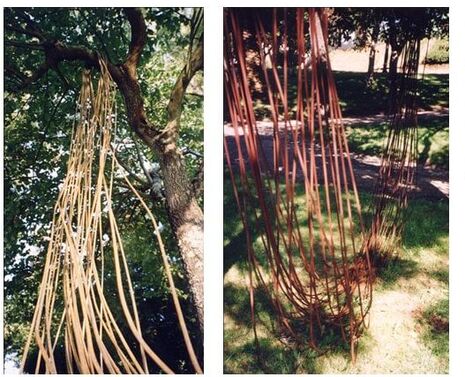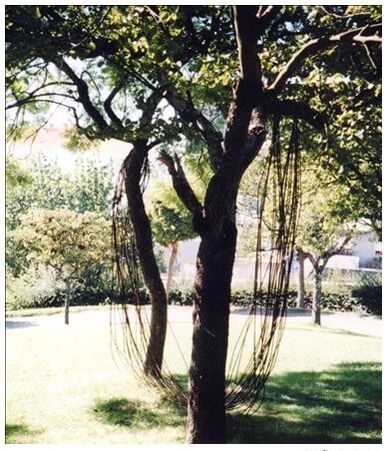União de Facto, 1998
Verga de Ferro, dimensões variáveis
Union of Fact, Unmarried, 1998
Iron, variable dimensions
A partir de 1998, Cláudia Amandi regressou à escultura enquanto modelação e definição do espaço. Na série de esculturas entre 1998 e 2000, Cláudia Amandi usou filamentos de metal como elemento estrutural e modelador das formas. As varas de metal, como fios, formam um aglomerado que permite a maleabilidade, adaptando-se a outros volumes e espaços, ou definindo novos espaços como cortinas tridimensionais. Usando esse princípio, Cláudia Amandi produz em 1988 a escultura União de facto enlaçando duas árvores com de cerca de 20 vergas de metal que funcionam como cabos. Dessa forma resulta uma configuração orgânica e maleável em diálogo com as formas das árvores, mantendo um vínculo decisivo para a evolução e história futura da escultura. Em diante, os cabos irão mover-se lentamente acompanhando o crescimento das árvores, mas num dado ponto, esses cabos irão criar uma tensão, aprisionando as árvores num nó. A dualidade da relação é representada por esse intervalo que se transforma ao longo do tempo, da ligação à pressão, da comunicação à força. Visualmente, a escultura integra-se nas formas orgânicas como um elemento que de algum modo se desenvolveu naturalmente. O processo de trabalho parte de uma leitura e interpretação do espaço, resultando numa intervenção marcada pela subtil interferência que se destaca para uma perceção atenta e disponível a elementos comuns do quotidiano.
In 1998, Claudia Amandi returned to sculpture as modelling and definition of space. In the series of sculptures between 1998 and 2000, Claudia Amandi used metal filaments as structural element and creation of volume. The metal rods, such as wires, form a cluster which allows flexibility, adapting to other volumes and spaces, or setting new spaces as three-dimensional curtains. Using this principle, Claudia Amandi produces in 1988 the sculpture ' Union of Fact’ (domestic partnership) linking two trees with about 20 metal cables. Thus organic, malleable configuration results in dialogue with the shapes of trees, keeping a link to the evolution of the piece. The cables will move slowly along the growth of the trees, but at some point, these cables will create a tension, trapping the trees in a node. The duality of the relationship is represented by this interval which becomes, over time, with the pressure of the communication. Visually, the sculpture is part of the organic forms as an element that somehow developed naturally. In this work, the interpretation of space, results in a dialogue marked by subtle interferences attentive to common elements of everyday life. (*)
In 1998, Claudia Amandi returned to sculpture as modelling and definition of space. In the series of sculptures between 1998 and 2000, Claudia Amandi used metal filaments as structural element and creation of volume. The metal rods, such as wires, form a cluster which allows flexibility, adapting to other volumes and spaces, or setting new spaces as three-dimensional curtains. Using this principle, Claudia Amandi produces in 1988 the sculpture ' Union of Fact’ (domestic partnership) linking two trees with about 20 metal cables. Thus organic, malleable configuration results in dialogue with the shapes of trees, keeping a link to the evolution of the piece. The cables will move slowly along the growth of the trees, but at some point, these cables will create a tension, trapping the trees in a node. The duality of the relationship is represented by this interval which becomes, over time, with the pressure of the communication. Visually, the sculpture is part of the organic forms as an element that somehow developed naturally. In this work, the interpretation of space, results in a dialogue marked by subtle interferences attentive to common elements of everyday life. (*)


